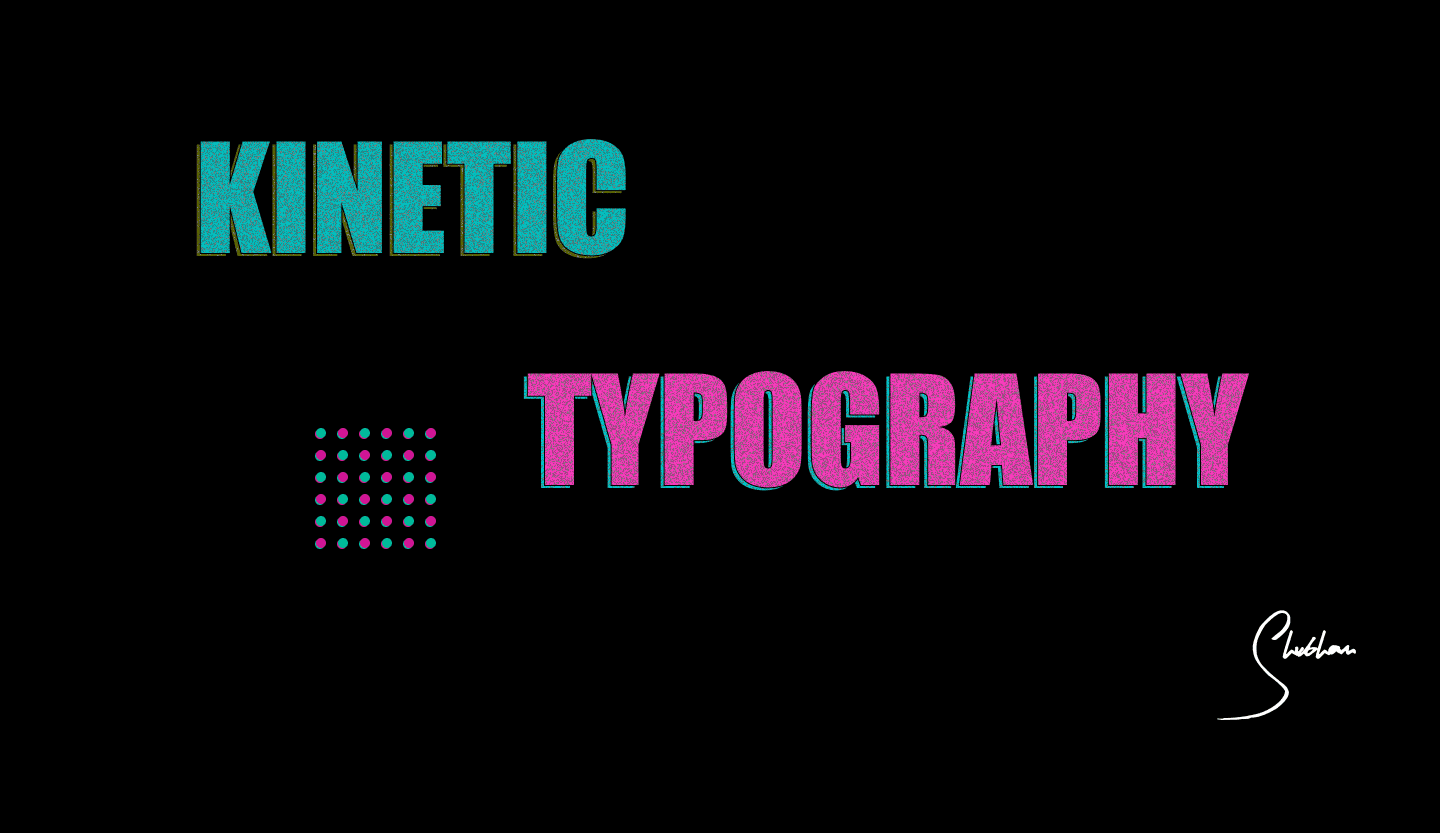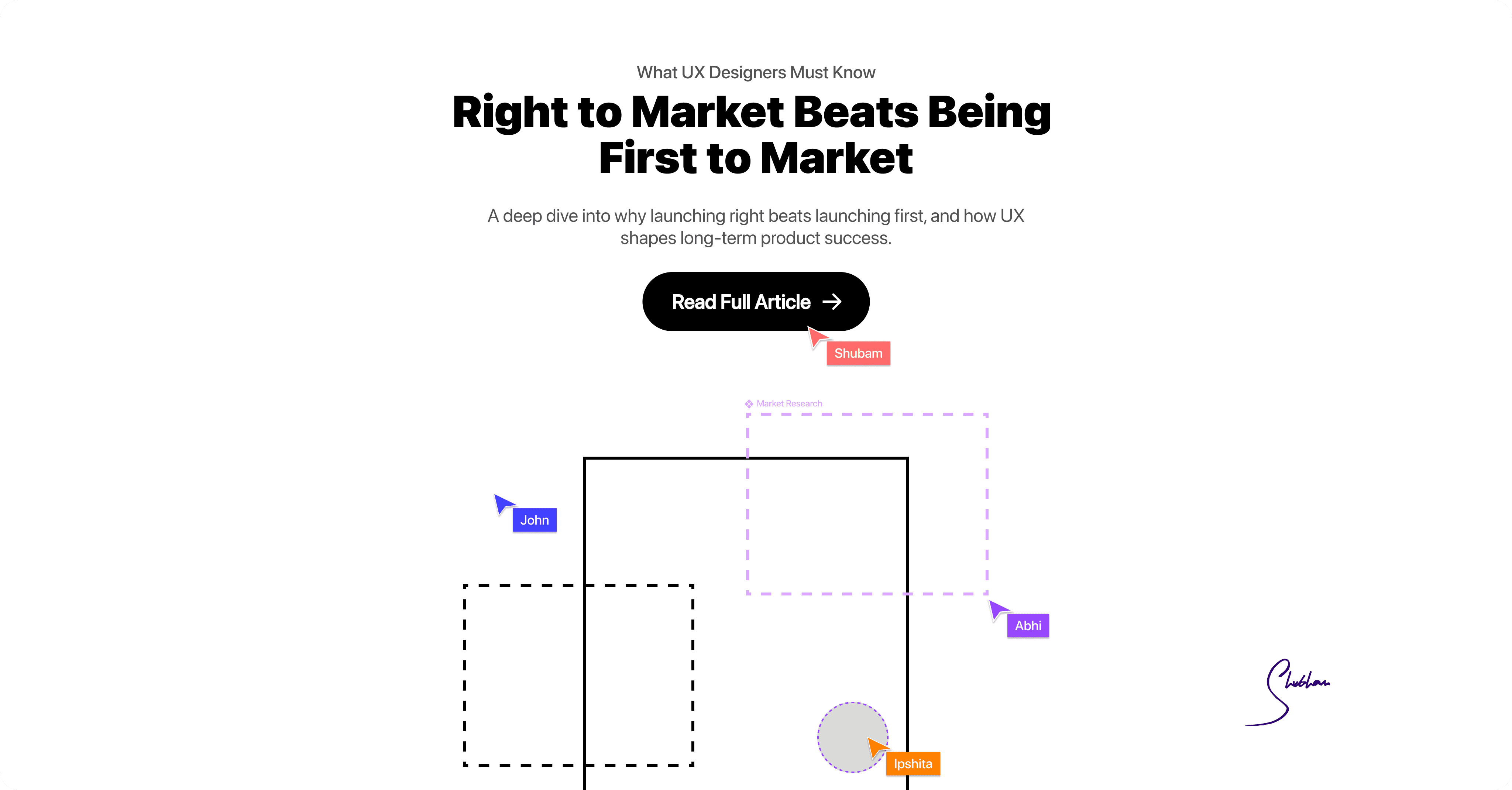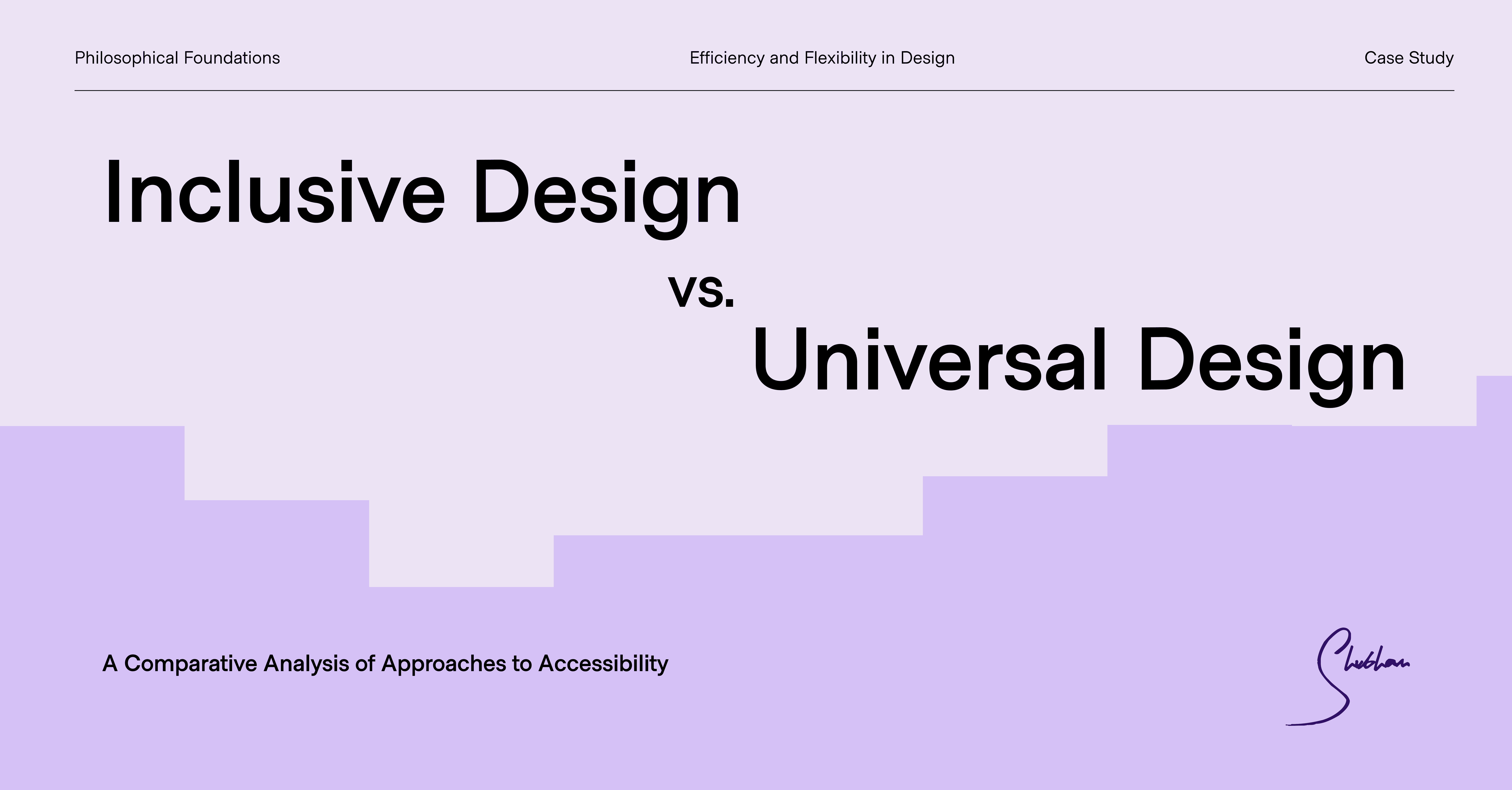Introduction: The Dynamic World of Kinetic Typography in UX
I learned about serif and sans serif typefaces, about varying the amount of space between different letter combinations, about what makes great typography great. — Steve Jobs
In the ever-evolving landscape of digital design, user experience (UX) professionals are constantly seeking innovative ways to captivate audiences and enhance engagement. Gone are the days when static text sufficed to convey information effectively. Today, words have transcended their fixed forms, embracing motion to create dynamic and immersive experiences. This transformation has ushered in the era of kinetic typography, a potent technique that blends the art of typography with the principles of animation. As a UX design researcher specializing in typography and motion graphics, I recognize kinetic typography as a valuable asset in a UX designer's toolkit, capable of transforming how users interact with and perceive digital interfaces. This blog post will delve into the intricacies of kinetic typography, exploring its definition, core principles, and the myriad benefits it offers for user engagement, information hierarchy, and emotional impact. We will also examine real-world examples through detailed case studies, address potential drawbacks and accessibility considerations, investigate its influence on user behavior, comprehension, and satisfaction, and ultimately, provide best practices for its effective integration into UX projects.
What is Kinetic Typography? Defining the Moving Text
Definition and Historical Context
Kinetic typography, often referred to as "moving text" or "motion typography," is an animation technique that brings words and phrases to life through movement, timing, and visual effects. It involves presenting text over time in a manner intended to convey or evoke a particular idea or emotion. This technique extends beyond mere changes in color or font; it fundamentally incorporates motion as a core element. While the term might sound contemporary, the concept has roots dating back to the early days of cinema. As early as 1899, the pioneering work of Georges Méliès showcased basic forms of text animation. However, true kinetic typography trends didn't emerge until the 1960s, significantly influenced by Saul Bass's groundbreaking title sequence for Alfred Hitchcock's 1959 film, "North by Northwest". This sequence, featuring animated credits that "flew" in from off-screen, is recognized as the first extensive use of kinetic typography in a feature film. Since then, the field has evolved, with design theorist Barbara Brownie proposing a model that divides kinetic typography into Motion Typography (including scrolling and dynamic layout) and Fluid Typography, where letterforms change and evolve without necessarily changing location. The increasing accessibility of sophisticated animation software has further democratized the use of kinetic typography, making it a more prevalent technique in various digital media. The journey from static text to dynamic, animated typography illustrates a growing understanding of how motion can significantly enhance visual communication, initially recognized in the captivating title sequences of films and now increasingly applied to engage users in the digital realm.
Core Principles in Visual Communication and Design
Kinetic typography, while embracing the dynamic nature of motion, is firmly grounded in the fundamental principles of traditional typography, such as hierarchy, contrast, and readability. However, its unique character is defined by several core principles specific to its animated form. Movement and Transformationare central, as the motion of text captures attention and adds impact to the message.10 This can manifest in various ways, from simple scrolling to more complex stretching, shrinking, spinning, and morphing effects. Establishing a clear Visual Hierarchy is crucial, and kinetic typography achieves this through typographic contrast, color, size, and the strategic use of motion to guide the viewer's eye. Motion can effectively emphasize key information and create a distinct hierarchy within the text. A well-executed kinetic design also considers the Balance of Movement and Rest, combining dynamic motion with static elements to ensure a harmonious flow and prevent visual fatigue. Alternating between fast-paced and slower sequences can create visual interest without overwhelming the viewer. For multimedia experiences, the Synchronization of Text and Audio is paramount, requiring a careful balance between text pacing and audio cues to deliver a cohesive and immersive narrative. The Timing and Pacing of text animations play a vital role in conveying the message effectively and evoking the desired emotions. Despite the motion, Legibility remains a top priority; animated text must not move so quickly or become so distorted that it becomes difficult to read. Furthermore, motion in typography can create a stronger Emotional Connection with the audience, amplifying the impact of the message. Finally, the strategic Use of White Space around moving text is essential for creating visually engaging layouts that capture attention without feeling cluttered. These core principles underscore that effective kinetic typography is not simply about making text move, but about carefully orchestrating that movement to enhance communication and user experience.
Unlocking Engagement: Benefits of Kinetic Typography in User Experience
Enhancing User Engagement and Attention
In today's digitally saturated world, capturing and retaining user attention is a significant challenge. Kinetic typography offers a powerful solution by leveraging the inherent human attraction to motion. Moving text naturally draws the eye and can effectively break through the phenomenon of banner blindness, where users tend to ignore static banner-like information. Dynamic text animations can significantly increase the time users spend on a page, encouraging them to explore the content further. This technique is particularly effective in making content stand out on crowded social media feeds and within the noisy landscape of digital environments. Furthermore, kinetic typography can be strategically employed to direct user attention to crucial elements such as calls-to-action (CTAs) or important announcements, making them more noticeable and impactful.
Improving Information Hierarchy and Clarity
Kinetic typography can play a crucial role in structuring and clarifying information within a user interface. By animating text in specific ways, designers can guide users through the content, revealing information sequentially or highlighting key elements to emphasize their importance. The use of varying animation styles, speeds, and sizes can effectively establish a visual hierarchy, indicating the relative significance of different text components. For instance, enter and exit animations can introduce and remove text elements in a structured manner, while sequential reveal techniques can improve the digestibility of long blocks of text by presenting information in manageable chunks. This approach not only enhances user engagement but also facilitates better comprehension of the presented information.
Creating Emotional Impact and Brand Personality
Beyond engagement and clarity, kinetic typography possesses a unique ability to evoke specific emotions and contribute to the development of a distinct brand personality. The movement, rhythm, and overall style of animated text can create a stronger emotional connection with the audience, amplifying the intended message. The thoughtful selection of font, color, and animation style can significantly contribute to the overall brand personality and voice, making it more memorable and relatable. For example, bouncy and energetic animations might be suitable for a playful brand, while subtle fades and elegant movements could better represent a sophisticated brand. By strategically employing kinetic typography, brands can infuse their digital presence with personality and create lasting impressions on their users.
Case Studies: Kinetic Typography in Action
To illustrate the effective application of kinetic typography in user experience, let's examine a couple of compelling case studies.
Case Study 1: Wodwo (AI Audience Modeling Platform)
Wodwo, an AI audience modeling platform, provides a compelling example of how kinetic typography can be strategically integrated into a website to enhance user experience and communicate complex information effectively. Their website, particularly the "how it works page", is a testament to the power of storytelling through dynamic text. On this page, Wodwo employs entry and exit typography to introduce and remove text elements gracefully, creating a structured and easy-to-follow flow of information. This ensures that users can focus on one piece of information at a time before seamlessly transitioning to the next. Furthermore, the website utilizes sequential reveal animations, where text elements build one by one, mimicking the process of writing. This technique not only increases user engagement by building anticipation but also aids in the progressive understanding of the platform's functionalities. By strategically implementing these kinetic typography patterns, Wodwo effectively guides the viewer's attention to each new piece of important information, encouraging them to delve deeper into how the AI audience modeling platform operates.1
On the homepage, Wodwo further enhances the user experience with subtle yet effective kinetic typography. A motion layout is used to create a visually appealing moving wave of text against the blue background, adding an element of dynamism and visual interest.1 Additionally, a sequential reveal effect is applied to the main heading and video in the center of the homepage. This ensures that visitors are immediately greeted with the school's unique value propositions, making a strong first impression and guiding them towards conversion. The thoughtful integration of kinetic typography throughout the Wodwo website contributes to increased user engagement, improved comprehension of complex information, and a more memorable and impactful brand experience.
Case Study 2: Apple (Marketing Campaigns)
Apple, a globally recognized brand, is renowned for its sophisticated and impactful visual communication, frequently incorporating kinetic typography into its marketing campaigns. A notable example is their campaign centered on achieving carbon neutrality for all products by 2030. In their promotional video, Apple effectively uses kinetic typography to highlight the key aspects of this significant environmental commitment in a manner that is both entertaining and easily understandable. The advertisement employs various kinetic text formats and colors to emphasize crucial points within the voiceover, ensuring that the message resonates with the audience. This strategic use of dynamic typography, combined with an upbeat soundtrack and a consistent green color palette, aims to create a positive and exciting perception of Apple's brand identity and sustainability initiatives. The result is a memorable communication of their environmental goals and a strengthened positive brand association.
Another compelling example of Apple's effective use of kinetic typography is in the video announcing the inclusion of eye-tracking features in their iPads and iPhones. The 26-second video opens with a captivating animation of the text: “Control iPad with your eyes,” immediately grabbing the viewer's attention. Throughout the rest of the video, Apple continues to utilize kinetic typography to highlight other key product updates, effectively making complex information more digestible and memorable for the audience. This approach not only educates consumers about the new features but also reinforces the key messaging, leading to better information retention and stronger brand recall. Apple's consistent and strategic use of kinetic typography in its marketing campaigns demonstrates its power in enhancing user engagement and effectively communicating key messages.
Brief Overview of Other Notable Examples
Beyond Wodwo and Apple, several other entities have effectively leveraged kinetic typography. Burger King's rebranding video stands out for its creative use of fluid typography, where the words "Burger King" are visually squeezed between two buns, synchronized with upbeat music. Sandler's website incorporates subtle hover and counter animations on headings to create user interaction and draw attention to key statistics, adding a layer of engagement to the homepage. G-uld, a Danish wool provider, cleverly integrates kinetic typography with a video in their hero element to beautifully guide website visitors through their core unique value propositions. Lastly, it's important to acknowledge the historical impact of Saul Bass's opening title sequence for Alfred Hitchcock's "North by Northwest," which remains a significant example of early and influential kinetic typography.
Case Study Name | Primary Goal | Key Kinetic Typography Techniques Used | Specific Effects | Impact on User Experience | Contribution to Communication Goals |
Wodwo | Explain complex platform functionality | Entry & Exit, Sequential Reveal, Motion Layout | Text fading in/out, letters building sequentially, text moving in a wave pattern | Improved understanding, increased engagement, enhanced navigation | Clear and engaging explanation of services |
Apple | Highlight key product features and brand values | Simple Motion, Emphasis | Text sliding, scaling, color changes to highlight key information | Better information retention, positive brand perception, immediate attention to key updates | Memorable communication of key benefits and brand messaging, clear articulation of environmental goals |
Table 1: Comparative Analysis of Kinetic Typography Implementation in Case Studies
Navigating the Challenges: Drawbacks and Accessibility Considerations
Potential Drawbacks of Using Kinetic Typography in UX Design
While kinetic typography offers numerous benefits, it's crucial to acknowledge potential drawbacks that UX designers must consider. One significant concern is the potential for increased page loading times, particularly when implementing complex animations. This can negatively impact the overall user experience, as slow loading times can lead to user frustration and higher bounce rates. Another challenge lies in the risk of overwhelming or distracting users with excessive or poorly executed animations. Too much motion can create a chaotic and unprofessional impression, detracting from the website's credibility and usability. Furthermore, if not implemented thoughtfully, animations can slow down interaction times, potentially frustrating users who aim for rapid task completion. Achieving a proper balance and exercising moderation in the use of kinetic typography is essential to avoid overwhelming users. Ineffective or overcrowded animation can even distract users from the core message and annoy them to the point of leaving the website altogether. Therefore, a strategic and purposeful approach is paramount to ensure that kinetic typography enhances rather than hinders the user experience.
Crucial Accessibility Considerations and Best Practices for Inclusive Design
Accessibility is a critical aspect of UX design, and kinetic typography requires careful consideration to ensure inclusivity for all users. Not all individuals appreciate or benefit from moving text, especially those with disabilities such as vestibular disorders, who may experience dizziness or discomfort from motion and transitions. Therefore, it is vital to maintain sufficient contrast between text and background colors to ensure readability for users with low vision or color vision deficiencies. Legibility of text, even when in motion, must be prioritized by choosing appropriate fonts and animation speeds. A fundamental best practice is to provide users with the option to pause or disable animations entirely to accommodate individual preferences and needs. For visually impaired users, considering text-to-speech compatibility is crucial, and offering alternative static versions of content that utilizes kinetic typography can significantly improve accessibility. Additionally, providing captioning options for any audio that accompanies kinetic typography ensures that hearing-impaired users can also access the information. Allowing users to customize playback speeds for animations can further enhance usability. Selecting appropriate font sizes and avoiding overly stylized fonts that can hinder readability are also essential for accessibility. Ensuring that animated text remains on screen long enough for users to read comfortably is another key consideration. Finally, for users with different learning styles, pairing kinetic typography with audio descriptions or other visual cues can create a more inclusive experience. By proactively addressing these accessibility considerations, designers can ensure that the benefits of kinetic typography are available to the widest possible audience.
The User Impact: Behavior, Comprehension, and Satisfaction
Research Findings on the Impact of Kinetic Typography on User Behavior
Engaging kinetic typography has a notable impact on user behavior within digital interfaces. Research indicates that it can lead to increased user interaction with websites and applications. The captivating nature of animated text often encourages visitors to spend more time on a site, exploring its content more thoroughly. In marketing and advertising contexts, kinetic typography has the potential to influence user decisions and behaviors by making messages more memorable and impactful. Well-executed kinetic typography can immediately capture the audience's attention and sustain their interest throughout the interaction.
Effects on User Comprehension and Information Retention
The dynamic presentation of text through kinetic typography can significantly enhance user comprehension and information retention compared to static text. By breaking down information into animated sequences, kinetic typography can make complex concepts more digestible and memorable. Studies suggest that moving text is more interesting and easier to recall than static text, leading to improved comprehension and retention of the presented information. This makes kinetic typography a valuable tool for educational content, tutorials, and any scenario where effective communication and memorability are crucial.
Influence on User Satisfaction and Overall Experience
Thoughtfully implemented kinetic typography can significantly elevate the overall user experience, making websites and apps feel more dynamic, engaging, and modern. It contributes to a more refined and contemporary feel of a digital product, potentially enhancing the perceived value of the brand. Kinetic typography has the power to transform the look and feel of a website or application, making it more memorable and impactful for users. When done well, it can elevate a user experience from being merely functional to becoming truly delightful. Positive interactions with well-designed kinetic typography can lead to better brand impressions and increased customer satisfaction, fostering a stronger connection between the user and the digital product.
The Importance of Kinetic Typography in Modern UX Design
The findings discussed throughout this exploration underscore the significant role of kinetic typography in contemporary UX design. Its importance stems from its remarkable ability to capture and hold user attention in today's information-saturated digital landscape. Kinetic typography enhances storytelling, creating engaging visual narratives that resonate with users. It proves effective in improving communication and message retention, ensuring that key information is not only seen but also understood and remembered. Furthermore, it adds visual interest and dynamism to user interfaces, making them more appealing and modern in the eyes of users. The strategic use of kinetic typography can also reinforce brand identity and personality through carefully chosen styles and movements, creating a more cohesive and memorable brand experience. Its ability to support visual hierarchy effectively guides user attention through content, ensuring that important information is easily scannable and understandable.1 When implemented thoughtfully, kinetic typography can even enhance accessibility for certain users, such as visual learners or those who benefit from synchronized text and audio. In an era where capturing and retaining user attention is paramount, kinetic typography stands out as a powerful tool for creating engaging, informative, and emotionally resonant digital experiences.
Best Practices and Guidelines for Effective Kinetic Typography in UX Projects
To harness the full potential of kinetic typography in UX projects, designers should adhere to several best practices and guidelines. Prioritizing Readability is paramount; the chosen fonts should remain legible even in motion, and the animation speed should allow for comfortable reading. Designers should Choose the Right Font, selecting typefaces that align with the message, brand personality, and overall aesthetic of the project. Establishing a Clear Visual Hierarchy is essential, using variations in size, weight, color, and animation style to guide the user's eye and indicate the importance of different text elements. It's crucial to Balance Motion with Rest, avoiding overwhelming users with constant movement and strategically incorporating static elements to provide visual breaks. If the kinetic typography accompanies audio, designers must Synchronize with Audio, ensuring the timing and pacing of the text animation align with the narration or sound effects. Using Color Strategically can highlight key words, create contrast, and reinforce brand identity. Paying close attention to Timing and Pacing involves carefully choreographing the speed and rhythm of animations to match the content and desired emotional impact. Optimizing for Performance is essential to ensure animations are lightweight and do not negatively affect page loading times or drain device battery. Designers must Design for Accessibility by providing options to pause or disable animations, ensuring sufficient color contrast, and considering compatibility with screen readers and other assistive technologies. It is crucial to Test and Iterate on kinetic typography implementations, gathering user feedback to ensure effectiveness and usability. Maintaining Consistency in the style of animation throughout the user interface or project will prevent a jarring or disjointed experience. Finally, kinetic typography should be used Strategically to highlight key messages, guide user attention, or enhance specific interactions, rather than being employed as a purely decorative element.
Conclusion: Embracing the Power of Moving Text in UX
In conclusion, kinetic typography represents a powerful evolution in digital communication, offering a dynamic and engaging alternative to static text. Its ability to capture attention, enhance storytelling, improve information retention, and reinforce brand identity makes it an invaluable tool in modern UX design. While potential drawbacks such as loading times and accessibility concerns must be carefully considered, adhering to best practices ensures that kinetic typography can be implemented effectively and inclusively. By prioritizing readability, maintaining visual hierarchy, balancing motion with rest, and optimizing for performance and accessibility, UX designers can harness the full potential of moving text to create compelling and user-centric digital experiences. As the digital landscape continues to evolve, the strategic and thoughtful application of kinetic typography will undoubtedly play an increasingly important role in shaping the future of user interaction and engagement.
Paraphrased using ChatGpt
References
Digital Silk. (n.d.). Kinetic Typography. Retrieved from https://www.digitalsilk.com/digital-trends/kinetic-typography/
Motiongility. (n.d.). Kinetic Typography. Retrieved from https://motiongility.com/kinetic-typography/
Wikipedia. (n.d.). Kinetic typography. Retrieved from https://en.wikipedia.org/wiki/Kinetic_typography
LottieFiles. (2024, September 6). The Key Advantages of Kinetic Typography in Design. Retrieved from https://lottiefiles.com/blog/design-inspiration/the-key-advantages-of-kinetic-typography-in-design
Vogue Fashion Institute. (2024, April 29). Role of Kinetic Typography in UI & UX. Retrieved from https://www.voguefashioninstitute.com/role-of-kinetic-typography-in-ui-ux/
Content Creatures. (n.d.). Kinetic Typography: Different Types of Animated Text. Retrieved from https://www.contentcreatures.com/kinetic-typography-different-types-of-animated-text/
Educational Voice. (2024, December 1). Creative Kinetic Typography. Retrieved from https://educationalvoice.co.uk/creative-kinetic-typography/
B2W. (n.d.). Kinetic Typography Animation Videos. Retrieved from https://www.b2w.tv/blog/kinetic-typography-animation-videos
Visual Hierarchy. (2025). Best Kinetic Typography Examples and Ideas. Retrieved from https://visualhierarchy.co/best-kinetic-typography-examples-and-ideas
Paradox Media. (2025, March 28). What are the Principles of Kinetic Typography and Web Design? Retrieved from https://paradoxmedia.com/what-are-the-principles-of-kinetic-typography-and-web-design/
Eggenhuizen, L. (2016). The Movement of Typography (Bachelor's thesis). Royal Academy of Art, The Hague. Upskillist. (2025). Top 7 Kinetic Typography Trends 2025. Retrieved from https://www.upskillist.com/blog/top-7-kinetic-typography-trends-2025/
Animation Video Services. (2024, August 26). 3 Best Principles for Kinetic Typography Videos. Retrieved from https://animationvideoservices.in/3-best-principles-for-kinetic-typography-videos/
UX Planet. (n.d.). Typography study guide for UX designers. Retrieved from https://uxplanet.org/typography-study-guide-for-ux-designers-e964460580e7
ResearchGate. (2024). Kinetic Typography in Digital Media. Retrieved from https://www.researchgate.net/publication/382470702_Kinetic_Typography_in_Digital_Media
Linearity. (n.d.). Kinetic Typography. Retrieved from https://www.linearity.io/blog/kinetic-typography/
UXcel. (n.d.). Beginner's Guide to Typographic Hierarchy. Retrieved from https://uxcel.com/blog/beginners-guide-to-typographic-hierarchy
Touch4it. (n.d.). The Power of Typography in UX. Retrieved from https://blog.touch4it.com/the-power-of-typography-in-ux
Dribbble. (n.d.). Kinetic Typography. Retrieved from https://dribbble.com/tags/kinetic-typography
Interaction Design Foundation. (n.d.). Visual Hierarchy. Retrieved from https://www.interaction-design.org/literature/topics/visual-hierarchy
SkillSuccess. (n.d.). Text Animations and Kinetic Typography. Retrieved from https://www.skillsuccess.com/course/text-animations-and-kinetic-typography/
Webizona. (n.d.). Typography in UX: User Experience Design. Retrieved from https://webizona.com/blog/typography-in-ux-user-experience-design
ResearchGate. (n.d.). Kinetic Typography in Digital Media. Retrieved from https://www.researchgate.net/publication/382470702_Kinetic_Typography_in_Digital_Media#:~:text=conclusions%20were%20drawn%3A&text=Information%20retention%20is%20increased%20by,digital%20media%2C%20according%20to%20research.&text=comprehension%20and%20information%20retention.&text=kinetic%20typography%20can%20evoke%20strong,%2C%20surprise%2C%20and%20amazement.
Motiongility. (n.d.). Kinetic Typography. Retrieved from https://motiongility.com/kinetic-typography/
GUVI. (2025). Typography in UI: Beginners Guide. Retrieved from https://www.guvi.in/blog/typography-in-ui-beginners-guide/
LottieFiles. (2024, September 6). The Key Advantages of Kinetic Typography in Design. Retrieved from https://lottiefiles.com/blog/design-inspiration/the-key-advantages-of-kinetic-typography-in-design
Paradox Media. (2025, March 28). What are the Principles of Kinetic Typography and Web Design? Retrieved from https://paradoxmedia.com/what-are-the-principles-of-kinetic-typography-and-web-design/
LottieFiles. (2024, September 6). The Key Advantages of Kinetic Typography in Design. Retrieved from https://lottiefiles.com/blog/design-inspiration/the-key-advantages-of-kinetic-typography-in-design
CRFT Video. (n.d.). Kinetic Typography. Retrieved from https://crftvideo.com/services/kinetic-typography/
Wyzowl. (n.d.). Kinetic Typography. Retrieved from https://www.wyzowl.com/kinetic-typography/
Educational Voice. (2024, December 1). Kinetic Typography. Retrieved from https://educationalvoice.co.uk/kinetic-typography/
Flux Academy. (n.d.). Visual Hierarchy Examples. Retrieved from https://www.flux-academy.com/blog/visual-hierarchy-examples
Big Drop. (2024, December 10). Kinetic Typography: Is it Worth It? Retrieved from https://www.bigdropinc.com/blog/kinetic-typography-is-it-worth-it/
Educational Voice. (2024, December 1). Creative Kinetic Typography. Retrieved from https://educationalvoice.co.uk/creative-kinetic-typography/
Paradox Media. (2025, March 28). What are the Principles of Kinetic Typography and Web Design? Retrieved from https://paradoxmedia.com/what-are-the-principles-of-kinetic-typography-and-web-design/
Webizona. (n.d.). Typography in UX: User Experience Design. Retrieved from https://webizona.com/blog/typography-in-ux-user-experience-design
Digital Silk. (n.d.). Kinetic Typography. Retrieved from https://www.digitalsilk.com/digital-trends/kinetic-typography/




